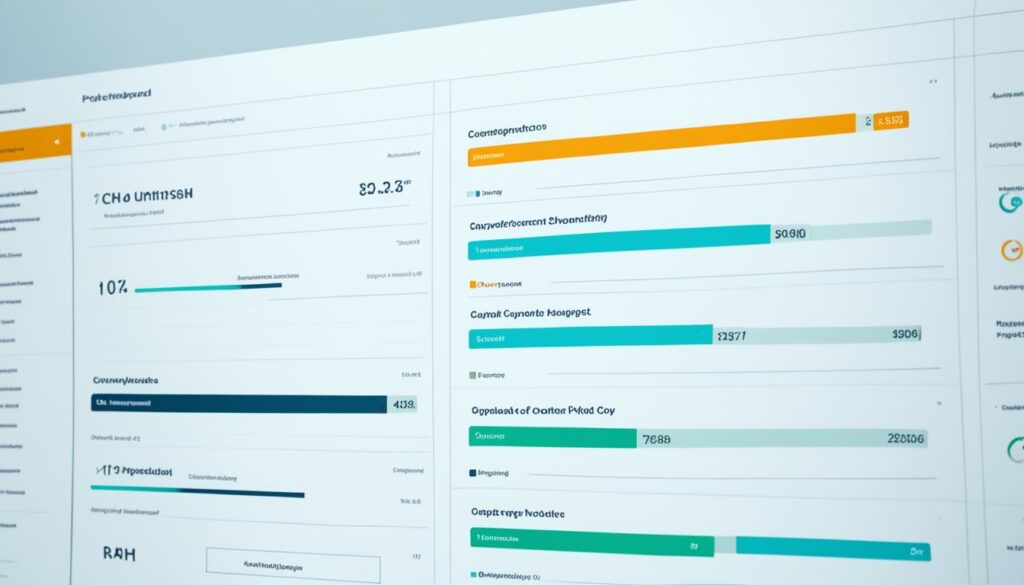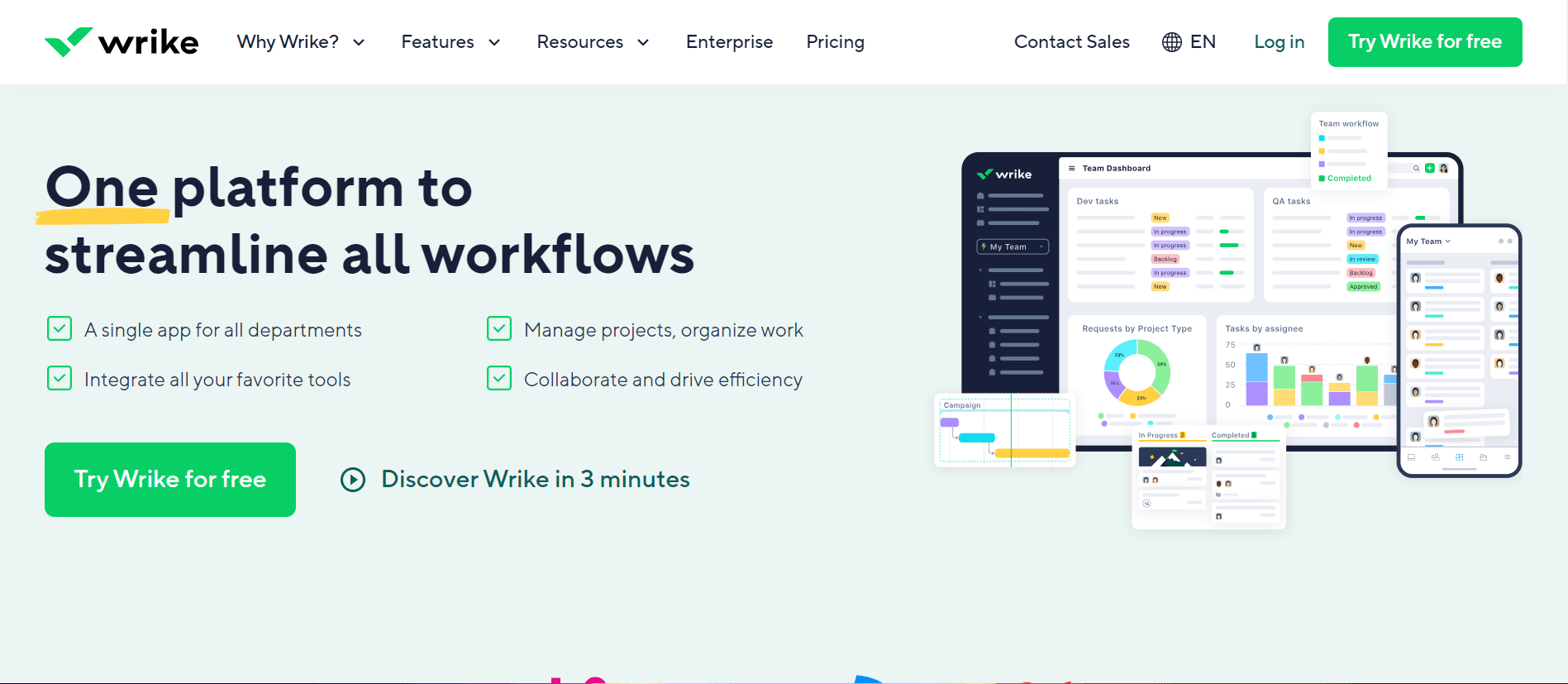wrike – In the fast-paced world of project management, efficiency is paramount. Every decision and action can impact the success of a project. So, how can organizations ensure that their projects are running smoothly and maximizing productivity?
Introducing Wrike, the ultimate project management tool that can revolutionize your project organization and execution. With its powerful automation capabilities, seamless resource management, and robust document management features, Wrike enables you to optimize your projects and achieve exceptional results.
So, are you ready to take your project management to the next level with Wrike?
Key Takeaways:
- Wrike is a comprehensive project management tool that offers automation, resource management, and document management features.
- Efficient project management is crucial for maximizing productivity and achieving exceptional results.
- Wrike helps optimize projects by streamlining processes, enhancing communication, and improving collaboration.
- With Wrike, organizations can track and allocate resources effectively, ensuring optimal utilization.
- By utilizing Wrike’s document management features, teams can easily access and share project-related files, fostering seamless collaboration.
The Importance of Performance Management
Performance management is a critical aspect of project management that ensures projects run efficiently and drive profitable outcomes. Without proper performance management, organizations risk missing opportunities for improvement, resulting in negative impacts on project outcomes and the overall bottom line. By implementing a performance management process, businesses can gain visibility into team strengths and weaknesses, identify workflow patterns, and automate processes to boost efficiency and maximize billable work.
The Impact of Performance Management
Performance management plays a vital role in project success by providing the following benefits:
- Visibility: Performance management provides organizations with visibility into the people and processes behind projects, enabling them to identify areas for improvement and optimize project outcomes.
- Efficiency: By identifying workflow patterns, performance management allows organizations to streamline processes, eliminate inefficiencies, and increase overall project efficiency.
- Maximized Bottom Line: Effective performance management directly impacts the bottom line by maximizing billable work and ensuring projects are completed within budget and on time.
With performance management in place, organizations can effectively monitor performance indicators, track costs and budgets, facilitate collaboration, and manage resources and workloads. This comprehensive approach empowers businesses to make data-driven decisions, measure ROI, and achieve optimum project outcomes.
Take a look at the image below to visualize the importance of performance management in driving project success:

In the next section, we will explore how performance management tools, specifically business performance management software, can significantly improve project management processes and outcomes.
How Performance Management Tools Improve Project Management
Performance management tools, such as business performance management software, play a crucial role in optimizing project management. These tools offer a wide range of capabilities that enhance project efficiency and effectiveness. Let’s explore how performance management tools can improve different aspects of project management:
Tracking Costs and Budgets
One of the key features of performance management tools is their ability to track costs and monitor project budgets. These tools provide real-time insights into project expenses, allowing project managers to proactively manage their budgets and make data-driven decisions to ensure financial objectives are met.
Role Definition and Resource Management
Performance management tools help define roles and responsibilities within a project team, ensuring that every team member understands their tasks and deliverables. Additionally, these tools enable effective resource management by providing visibility into resource availability, workload distribution, and potential bottlenecks.
Flexible Scheduling and Communication
With performance management tools, project managers can create flexible schedules that accommodate changing project requirements and resource availability. These tools facilitate seamless communication among team members, allowing for efficient collaboration, timely updates, and the resolution of any issues that may arise during the project cycle.
Key Performance Indicators (KPIs) and ROI Measurement
Performance management tools enable project managers to define and track key performance indicators (KPIs) specific to their projects. By monitoring these KPIs, project managers can assess project progress, identify areas for improvement, and make informed decisions to optimize project outcomes. Furthermore, these tools facilitate the measurement of Return on Investment (ROI), helping organizations determine the overall success and value of their projects.
To illustrate the benefits of performance management tools in project management, consider the following example:
“By implementing a performance management tool, XYZ Company was able to track project costs in real-time, leading to a 15% reduction in overall project expenses. The tool also allowed for efficient resource management, resulting in a 10% increase in team productivity. With the ability to set and monitor KPIs, XYZ Company improved project outcomes by 20%, ultimately driving a higher ROI for their clients.”
As the example highlights, performance management tools provide valuable insights and functionalities that support project managers in delivering successful projects. Now, let’s take a closer look at a comprehensive table that summarizes the key features and benefits of performance management tools:
| Feature | Benefit |
|---|---|
| Cost and Budget Tracking | Enables efficient financial management and ensures project budget adherence. |
| Role Definition and Resource Management | Improves team coordination, optimizes resource allocation, and minimizes bottlenecks. |
| Flexible Scheduling and Communication | Facilitates effective collaboration, timely updates, and seamless communication. |
| Key Performance Indicators (KPIs) | Allows for tracking and evaluation of project performance against set objectives. |
| Return on Investment (ROI) Measurement | Assesses project success and determines the financial impact of project outcomes. |

In the next section, we will delve into the importance of measuring project performance and discuss the various metrics and indicators organizations can utilize to gauge their project’s success.
Measuring Project Performance
Measuring project performance is a critical aspect of successful project management. It involves evaluating various factors to ensure projects are on track and achieving their intended goals. By assessing adherence to timelines and budgets, tracking direct project impact, measuring ROI and stakeholder engagement, organizations can gauge the effectiveness of their projects and make necessary adjustments for optimal outcomes.
Adherence to Timelines and Budgets
Keeping projects within designated timelines and budgets is essential for project success. By regularly monitoring and measuring project progress, teams can identify any deviations from the original plan and implement corrective actions. This allows for better resource allocation, prevents unnecessary delays, and ensures project milestones are achieved in a timely manner.
Direct Project Impact on Business Goals
Measuring the direct impact of a project on specific business goals provides valuable insights into the project’s effectiveness. By establishing clear goals and key performance indicators (KPIs) at the outset, project managers can track and evaluate the project’s contribution to overall business objectives. This helps stakeholders understand the value and alignment of the project with organizational strategies.
Measuring Return on Investment (ROI)
ROI measurement is crucial to determine the financial impact of a project. By analyzing the costs incurred and the benefits generated, organizations can assess the project’s profitability and make informed decisions about future investments. Measuring ROI provides a clear picture of the project’s monetary value and helps justify the resources allocated to its execution.
Stakeholder Engagement and Support
Measuring stakeholder engagement and support is vital for project success. Engaged stakeholders provide valuable input, support, and resources, ensuring project alignment with organizational goals. Regular communication and feedback mechanisms enable project managers to evaluate stakeholder satisfaction and make adjustments to enhance stakeholder engagement throughout the project lifecycle.
“Measuring project performance allows organizations to identify areas for improvement and demonstrate the value and success of projects to stakeholders.”
Key Metrics for Measuring Project Performance
| Metric | Description |
|---|---|
| Timelines | Evaluating adherence to project schedules and milestones |
| Budgets | Tracking project costs in comparison to the allocated budget |
| ROI | Assessing the financial impact and profitability of the project |
| Stakeholder Engagement | Evaluating the level of involvement and support from project stakeholders |
Measuring project performance through these key metrics enables organizations to gain valuable insights into the success and efficiency of their projects. By having a comprehensive understanding of project performance, stakeholders can make data-driven decisions and take corrective measures when necessary, ensuring the achievement of project goals and delivering favorable outcomes.
Choosing the Best Performance Management Software
When it comes to performance management, selecting the right software is crucial. The right tools can enhance project management capabilities, improve team efficiency, and drive successful outcomes. When evaluating performance management software options, consider key features that align with your organization’s needs and goals:
- Time Tracking: Accurately track the time spent on individual tasks and projects for better resource allocation and project scheduling.
- Workflow Automation: Streamline processes by automating repetitive tasks, reducing manual effort, and improving productivity.
- Customizable Dashboards: Create personalized dashboards that provide real-time insights into project progress, KPIs, and team performance.
- Real-Time Communication: Foster collaboration and communication across teams with features like instant messaging, file sharing, and discussion boards.
One performance management software that offers these key features is Wrike. By incorporating time tracking, workflow automation, customizable dashboards, and real-time communication capabilities, Wrike empowers organizations to optimize their project management processes. To see if Wrike is the right fit for your needs, take advantage of their free two-week trial.
Make an informed decision by trying out different software solutions and assessing how well they align with your specific requirements. By selecting the best performance management software, you can maximize your team’s efficiency, increase productivity, and achieve optimal project outcomes.
Performance Management Software Comparison
| Feature | Wrike | Competitor A | Competitor B |
|---|---|---|---|
| Time Tracking | ✓ | ✓ | ✗ |
| Workflow Automation | ✓ | ✓ | ✓ |
| Customizable Dashboards | ✓ | ✗ | ✓ |
| Real-Time Communication | ✓ | ✗ | ✓ |
Table: Comparison of key features offered by performance management software
The Benefits of Integrated Project Management
Integrated project management offers numerous advantages when it comes to effectively tracking project progress and ensuring a more precise and accurate workflow. By adopting a holistic approach, project managers can gain a comprehensive view of resource utilization and project status, leading to improved efficiency and higher-quality outcomes.
Integrated project management systems provide the necessary tools for better time and resource management, allowing project teams to optimize operations and enhance collaboration. This comprehensive approach is essential for achieving increased customer satisfaction and driving business growth.
One of the key benefits of integrated project management is progress tracking. By implementing a system that enables real-time progress tracking, project managers can stay informed about the status of individual tasks, milestones, and overall project progress. This visibility allows for proactive decision-making, timely adjustments, and the ability to address any issues that may arise.
Integration Of Project Management
Efficiency is another significant advantage of integrated project management. By centralizing project data and establishing a cohesive workflow, teams can streamline processes, eliminate redundancies, and minimize time wasted on manual coordination. This holistic approach ensures that tasks are completed efficiently, deadlines are met, and resources are effectively allocated.
In addition to improving efficiency, integrated project management also directly contributes to the overall quality of project outcomes. With a clear overview of resources, timelines, and dependencies, project managers can proactively address any potential bottlenecks or issues that could impact the project’s success. This proactive approach leads to better decision-making, risk mitigation, and ultimately, higher-quality deliverables.
Furthermore, integrated project management promotes a collaborative environment where teams can effectively communicate and work together towards common goals. By having a centralized platform for project-related discussions, document sharing, and task assignments, team members can easily collaborate and maintain open lines of communication. This seamless and transparent collaboration facilitates knowledge sharing, reduces misunderstandings, and improves overall team synergy.
To summarize, integrated project management offers a comprehensive and efficient approach to project execution. By tracking progress, embracing a holistic perspective, and boosting collaboration, organizations can achieve higher-quality outcomes, maximize efficiency, and ultimately, drive business success.

How Project Management Software Boosts Productivity
Project management software plays a pivotal role in boosting productivity by providing a range of features that optimize workflows and enhance collaboration. Let’s explore how project management software, such as Wrike, can help teams achieve their goals more efficiently.
Visualization of Goals, Deadlines, and Tasks: Project management software allows teams to visualize their goals, deadlines, milestones, and tasks in a clear and organized manner. This visual representation helps team members understand their roles and responsibilities, enabling them to focus on their assigned tasks and work towards accomplishing project objectives.
Goal Setting and Alignment: Effective goal setting is crucial for project success. Project management software empowers teams to set SMART (Specific, Measurable, Achievable, Relevant, Time-bound) goals, ensuring alignment among team members and stakeholders. By clearly defining project objectives within the software, teams can stay focused and track progress towards achieving their goals.
Better Communication and Collaboration:
Communication is the backbone of successful project management. Project management software provides centralized platforms for real-time communication, allowing team members to collaborate efficiently. With features like instant messaging, file sharing, and activity feeds, project management software fosters seamless communication, reducing the need for long email threads and meetings.
Real-Time Updates and Monitoring: Real-time updates are essential for keeping projects on track. Project management software enables teams to stay updated with the latest project status, progress, and changes. Managers can monitor project timelines, identify bottlenecks, and make informed decisions based on real-time data. This timely visibility contributes to improved project performance and ensures prompt action when deviations occur.
As a visual representation of goals, deadlines, and tasks, project management software enhances productivity by providing clarity and structure. The efficient organization of project data and real time updates minimize confusion and enable smooth project execution. Take a look at the table below to see how project management software features align with productivity benefits:
| Project Management Software Features | Productivity Benefits |
|---|---|
| Automated Workflows | Streamlined task execution and reduced manual effort |
| Agile Teamwork Templates | Improved collaboration and adaptability to changing project needs |
| Real-Time Tracking | Constant visibility into project progress and performance |
| Resource Management Tools | Optimized resource allocation and workload balancing |
Table: Project Management Software Features and Productivity Benefits
Project management software, such as Wrike, equips teams with the necessary tools to boost productivity through watch, goal setting, communication, and real time updates. By taking advantage of these features, organizations can display their project management processes and achieve efficient project delivery.

Concrete Ways to Use Project Management Processes
Project managers and directors can leverage project management processes effectively by employing specific strategies and practices to optimize their projects. The following are concrete ways to make the most of project management processes:
- Create Custom Automated Workflows: Automation plays a vital role in streamlining task assignment and reducing manual effort. By setting up custom automated workflows using project management software, teams can ensure seamless task delegation and eliminate bottlenecks. This not only increases productivity but also improves efficiency and reduces errors.
- Implement Agile Teamwork Principles: Embracing Agile teamwork principles fosters collaboration, flexibility, and adaptability within the team. Agile methodologies emphasize iterative, incremental project development and continuous improvement. By implementing Agile practices, project teams can respond quickly to changing requirements, enhance communication, and deliver high-quality results.
- Track Projects in Real Time: Real-time tracking allows project managers to monitor project progress, identify bottlenecks, and ensure timely completion. By incorporating project management software tools that offer real-time tracking capabilities, teams can have a clear overview of project status, milestones, and deadlines. This enables accurate reporting and enables client updates, improving transparency and client satisfaction.
- Optimize Resource Management: Efficient resource management is vital for project success. By strategically balancing workloads, optimizing scheduling, and allocating resources effectively, project managers can ensure that resources are utilized optimally. This ensures teams have the necessary capacity to complete tasks and deliver high-quality projects, ultimately leading to client satisfaction and project success.
Implementing these techniques enables teams to achieve better results, improve efficiency, and deliver high-quality projects. Whether it’s streamlining task assignment, embracing agile principles, tracking projects in real time, or optimizing resource management, project management processes lay the foundation for project success and organizational growth.

The Importance of Process Optimization
Process optimization plays a vital role in streamlining operations, maximizing resource utilization, reducing errors, improving quality, and ultimately enhancing customer satisfaction. By analyzing and improving project processes, organizations can eliminate inefficiencies, automate repetitive tasks, and achieve optimal project outcomes.
Process optimization is an internal part of business decision making and Agile project management, allowing project teams to continue improve their work and deliver high quality projects. By implement efficient processes, organizations can achieve greater productivity, cost savings, and competitive advantage in the market.
Streamlining Operations
Through process optimization, organizations can streamline their operations and eliminate unsoughted steps or bottlenecks in the work . By identify and removing lazy teams , teams can complete tasks more quickly and efficiently, reducing project timeline and improve overall project delivery.
Maximizing Resource Utilization
Process optimization helps organizations effectively manage their resources and ensure optimal utilize . By studing and renew processes, teams can put resources more efficiently, reducing waste and improve productivity. This not only saves time and costs but also enhances the overall performance of the project.
Reducing Errors
Error reduction is a critical aspect of process optimization. By knowing and address potential error points in the work , organizations can minimize mistakes, rework, and costly delays. Implementing standard processes, quality controls, and error prevention measures significantly improves project outcomes and customer satisfaction.
Improving Quality
Quality improvement is a central focus of process optimization. By streamlining operations and reducing errors, organizations can consistently deliver high quality projects that meet or exceed customer expectations. Process optimization enables teams to identify areas of improvement, implement best practices, and ensure adherence to quality standards throughout the project lifecycle.
Enhancing Customer Satisfaction With Wrike
Process optimization directly impacts customer satisfaction by improving project delivery, reducing errors, and enhancing the overall quality of work. By consistently delivering projects on time, within budget, and with high-quality results, organizations can build trust, loyalty, and positive relationships with their customers.
“Process optimization is not just about improving operational efficiency; it is about aligning the entire organization towards delivering exceptional customer value.” – John Smith, CEO of OptiPro Solutions.
By prioritizing process optimization, organizations can achieve operational excellence, drive continuous improvement, and gain a competitive edge in the market. It is an ongoing effort that requires a commitment to identifying, analyzing, and improving processes, supported by the right tools and technologies.

| Benefits of Process Optimization | Examples |
|---|---|
| Improved efficiency and productivity | Reduction in project timelines and increased output |
| Cost savings | Minimized waste and optimized resource allocation |
| Enhanced quality | Reduced errors, improved accuracy, and compliance |
| Increased customer satisfaction | On-time delivery, high-quality results, and improved communication |
| Competitive advantage | More efficient operations, faster time-to-market, and better customer service |
Challenges and Methods of Process Optimization
Process optimization is a valuable practice that brings efficiency and effectiveness to project management. However, it is not without its challenges. Some of the key hurdles that organizations face when implementing process optimization include:
- Resource-Intensive: Process optimization requires time, effort, and resources to analyze and improve existing processes. It may involve conducting thorough data analysis, identifying bottlenecks, and implementing changes.
- Resistance to Change: Change management plays a crucial role in process optimization. Resistance from employees who are accustomed to existing processes can hinder the success of optimization initiatives. Effective communication and employee engagement are essential to overcome this challenge.
- Optimization for the Sake of Optimization: The risk of optimizing processes without a clear goal or purpose can lead to unusual changes that do not add value or improve outcomes. It is important to align process optimization with the overall objectives and needs of the organization.
Despite these challenges, there are proven methods and techniques that can help organizations overcome obstacles and perfect their processes effectively.
Some widely adopted process optimization methods include:
- Process Mining: Process mining is a data driven approach that uses event logs to analyze and discover patterns in existing processes. It helps identify waste of time , bottlenecks, and areas for improvement.
- DMAIC (Define, Measure, Analyze, Improve, Control): DMAIC is a perfect problem solving study widely used in process improvement projects. It provides a step by step framework to define the problem, measure the current process performance, analyze root causes, implement improvements, and establish control measures.
- PDSA (Plan, Do, Study, Act): PDSA is another popular method for continuous improvement. It involves planning a change, apply it on a small scale, studying the results, and acting on what is learned from the study.
The application of these process optimization methods helps organizations make data driven decisions, identify areas for improvement, and implement changes that lead to touch to outcomes. By addressing challenges and quality effective easy techniques, businesses can perfect their operations, enhance efficiency, and achieve their desired project outcomes.
Comparison of Process Optimization Methods
| Method | Key Features | Benefits |
|---|---|---|
| Process Mining | – Uses event logs for analysis – Identifies bottlenecks and inefficiencies – Provides data-driven insights | – Improved process visibility – Streamlined workflows – Enhanced efficiency |
| DMAIC | – Define, Measure, Analyze, Improve, Control framework – Statistical tools for analysis – Root cause identification | – Structured problem-solving – Data-based decision-making – Process improvements based on root causes |
| PDSA | – Plan, Do, Study, Act methodology – Small-scale testing and evaluation – Continuous improvement | – Iterative process enhancements – Learning from small-scale changes – Adaptability and agility |
Implementing these process optimization methods enables organizations to optimize their processes, improve efficiency, reduce costs, and achieve better project outcomes.

Conclusion
Process of perfect match is a crucial aspect of project management. To make able organizations to put in order operations, improve efficiency, and deliver high quality projects. By using performance management tools and project management software like Wrike. Businesses can strenth processes, maximize resource utilize , reduce errors, and enhance customer satisfaction.
Implementing process in perfect methods and giving key stakeholders in decision making ensures the success of perfect initiatives. With Wrike’s versatile platform, project managers can customize work. And control tasks, communicate effectively, and track progress, making it a valuable tool for process optimization.
By optimizing processes using Wrike, businesses can achieve greater efficiency, minimize bottlenecks, and improve the overall project management experience. The software’s features. such as customizable work and control task assignments. Enable teams to work together seamlessly, resulting in improved productivity and time savings.
In conclusion, process perfect is a vital strategy for organizations seeking to increase their project management capabilities. By the formation and registration of a limited company. performance management tools like Wrike. Businesses can optimize processes, enhance collaboration, and ultimately deliver successful projects with improved efficiency and customer satisfaction.
FAQ
What is performance management?
Performance management is a process that involves measuring key performance indicators, tracking costs and budgets, facilitating communication and collaboration, managing resources and workloads, measuring ROI, and enabling end-to-end project performance management.
Why is performance management important?
Performance management is essential for ensuring projects are running efficiently and profitably. It provides visibility into team strengths and weaknesses, identifies workflow patterns, and automates processes to boost efficiency and maximize billable work.
How do performance management tools improve project management?
Performance management tools, such as business performance management software, track costs, monitor budgets, define roles and responsibilities, prioritize work, facilitate communication, measure margins and cash flow, set key performance indicators, measure ROI, and enable end-to-end project performance management.
What is project performance measurement?
Project performance measurement involves assessing adherence to timelines and budgets, tracking direct project impact on business goals, measuring ROI and financial impact, and evaluating stakeholder engagement and support.
How can I choose the best performance management software?
When selecting performance management software, consider key features such as time tracking, workflow automation, customizable dashboards, and real-time communication. Trying out software solutions like Wrike offers a free two-week trial to help companies find the right performance management software.
What are the benefits of integrated project management?
Integrated project management provides a holistic approach to tracking project progress, improves efficiency and outcomes, enhances resource utilization, optimizes operations, and enhances team collaboration.
How does project management software boost productivity?
Project management software enhances productivity by providing visualization of goals, milestones, tasks, and status updates. It improves communication, to put it on processes, and allows for efficient organization and goal-setting.
How can I use project management processes effectively?
You can use project management processes effectively by creating custom work , carry out Agile teamwork principles, tracking projects in real-time, and optimizing resource management through workload balancing and efficient scheduling.
Why is process optimization important for project management?
Process optimization is crucial for streamlining operations, maximizing resource use, reducing errors, improving quality, and enhancing customer satisfaction. It allows project teams to continuously improve their workflows and deliver optimal project outcomes.
What are the challenges and methods of process optimization?
Challenges of process optimize include resource s, resistance to change, and the risk of optimization for the sake of optimization. Methods such as process mining, DMAIC (Define, Measure, Analyze, Improve, Control), and PDSA (Plan, Do, Study, Act) can help overcome these challenges.
Share this content:


